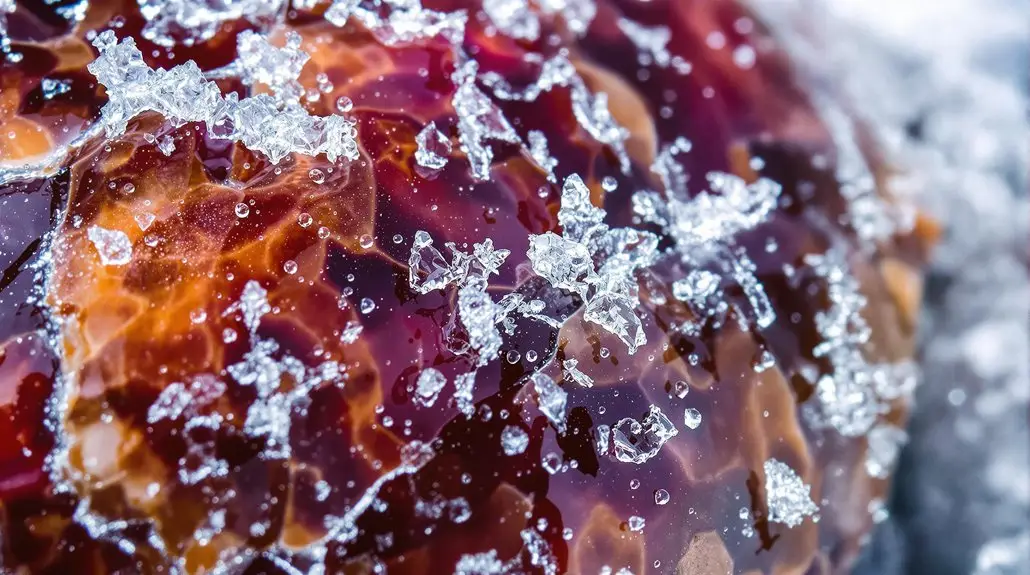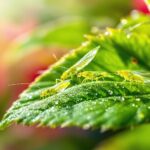Researchers Juang-Horng Chong, Amy L. Roda, and Catharine M. Mannion studied the mortality rates of the lobate lac scale, *Paratachardina pseudolobata*, in Florida when exposed to near or below freezing temperatures. Their findings indicate complete mortality occurs at temperatures below -10°C, with nymphs and adults displaying varying survival rates. Understanding these temperature effects is essential for managing this pest, which poses significant threats to local flora. Discovering further implications of this research may provide greater insights into effective control strategies.
Key Insights
- Lobate lac scale exhibits complete mortality at temperatures below -10°C within hours, impacting its population in Florida.
- Nymphs and adults show differing survival rates under cold exposure, with adults facing rapid mortality at extreme cold.
- Cold tolerance significantly influences the potential spread of Lobate lac scale in varying climates and environments.
- Understanding cold mortality rates aids in developing effective pest management strategies for controlling Lobate lac scale infestations.
- Effective pest management may integrate insecticide application and biological control, considering temperature effects on Lobate lac scale mortality.
Overview of Lobate Lac Scale
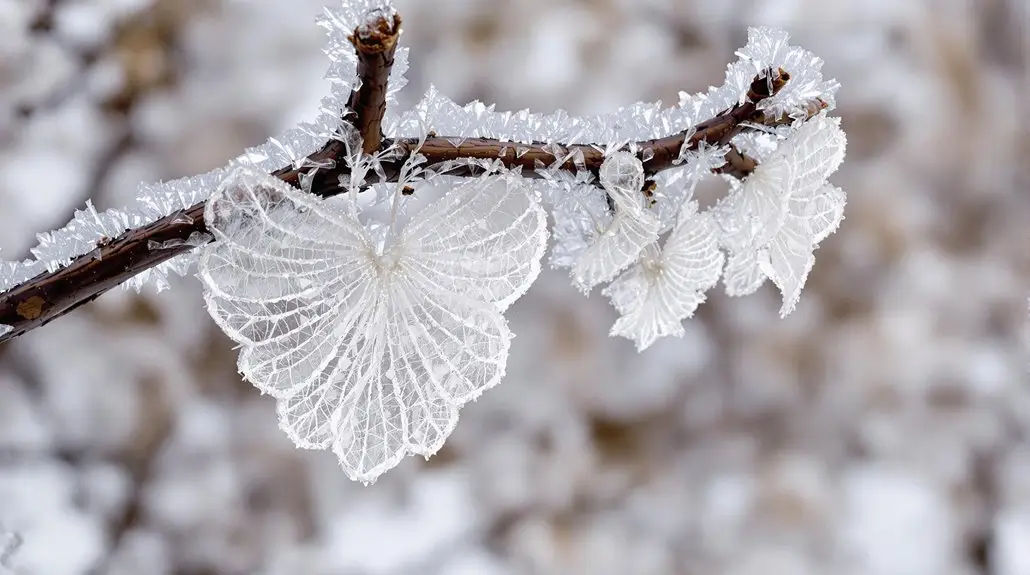
The Lobate Lac Scale, scientifically known as *Paratachardina pseudolobata*, represents a significant pest affecting a wide range of woody plants in Florida. Mature females measure about 1.5–2 mm in size, displaying a distinctive body structure characterized by two pairs of prominent lobes. Initially dark reddish-brown, their color often appears dull and black due to the presence of sooty mold, a byproduct of honeydew produced by the scales. Infestations typically occur on the woody portions of twigs and small branches, leading to branch dieback in heavily affected plants. With over 150 species of woody plants as potential hosts, including 39 native Florida species, the lobate lac scale poses a considerable threat, especially to shrubs and small trees in warmer climates. The scale is known to infest over 120 species across various plant families, increasing its risk of spread in urban areas.
Distribution and Nativeness
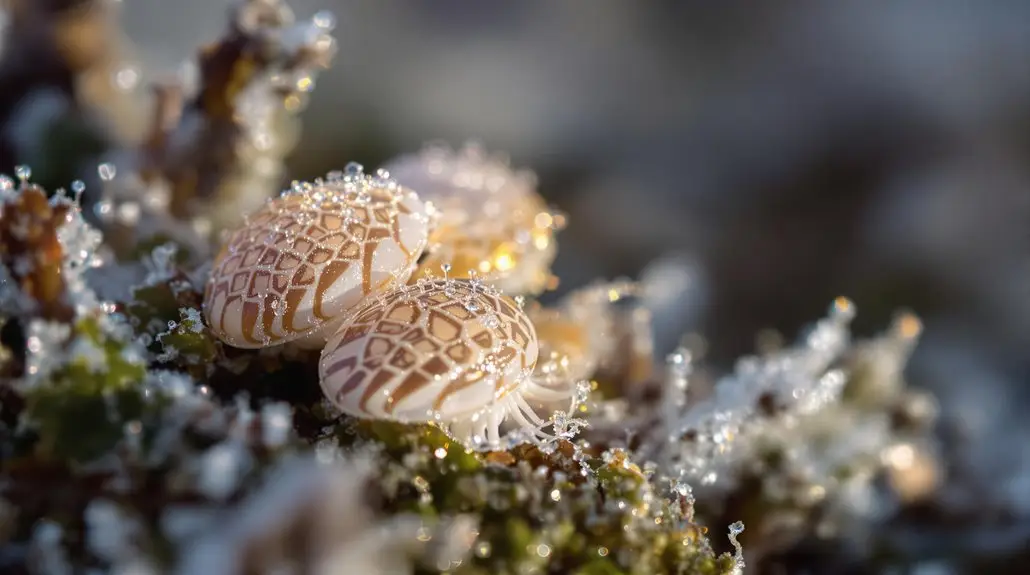
Identifying the distribution and nativeness of *Paratachardina pseudolobata* reveals its significant impact on Florida’s ecosystems and economy. This invasive species, first detected in Broward County in 1999, has rapidly spread across Southeastern Florida, primarily in counties south of Lake Okeechobee. Initially misidentified as *P. lobata*, *P. pseudolobata* is likely native to Asia or Oceania, and its presence in Florida poses challenges for local flora. The species thrives in warm, subtropical climates, leading to considerable ecological and economic concerns as it damages native vegetation. With its spread aided by infested nursery stock, researchers face difficulties in controlling its population and alleviating its effects on Florida’s natural areas, emphasizing the need for proactive management strategies. Notably, *P. pseudolobata* reproduces parthenogenetically, which contributes to its rapid population growth and resilience in the face of control efforts. Additionally, its presence exacerbates issues with common pests such as ants and termites, which further threatens Florida’s biodiversity.
Host Range and Plant Impact
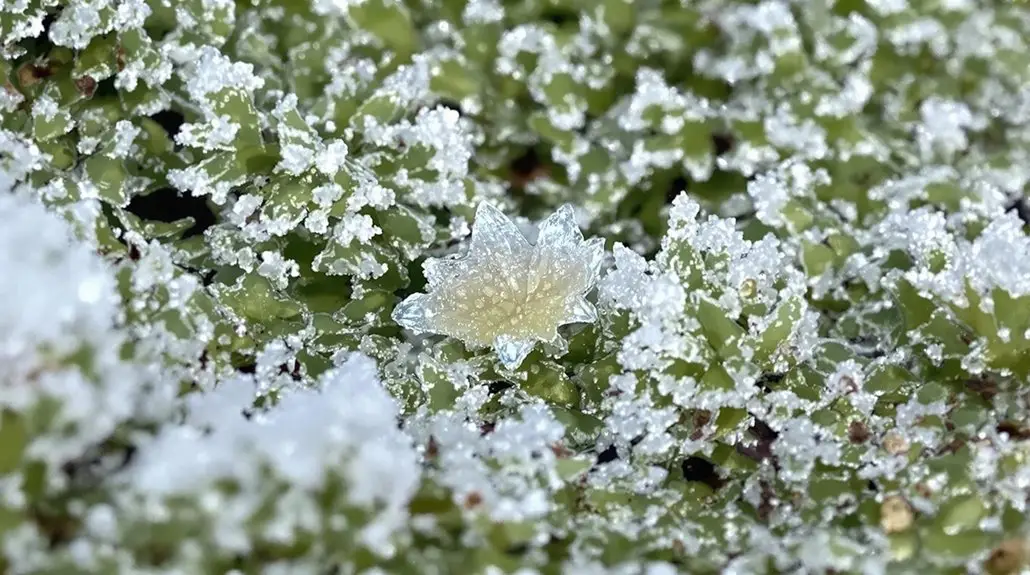
While exploring the host range of *Paratachardina pseudolobata*, researchers have discovered that this invasive lobate lac scale infests over 300 species of primarily woody plants, spanning 69 different families. Among these, the scale particularly favors members of the Fabaceae, Myrtaceae, and Moraceae families, with notable examples including *Dalea carthagenensis* var. *floridana* and *Syzygium cumini*. The scale primarily targets twigs and small branches, leading to heavy infestations where up to 42 mature females can inhabit just 1 cm of twig. Such dense populations create a dark, lumpy crust, causing branch dieback and even death in small trees and shrubs. Additionally, the secretion of honeydew promotes sooty mold growth, further impacting plant health and ecosystem stability. This widespread infestation highlights the scale’s high potential for further spread in warm areas with plant movement.
Temperature Effects on Mortality
In exploring temperature effects on the mortality of lobate lac scales, researchers identified vital mortality thresholds that highlight the vulnerability of both nymphs and adults. Studies show that exposure to extreme cold markedly impacts survival rates, with complete mortality occurring at temperatures below -10°C within just a few hours. Understanding these temperature survival patterns is essential for predicting the potential spread of this pest and developing effective control strategies in warmer regions. This is particularly relevant as the American Sand Wasp serves as a natural predator, potentially influencing the population dynamics of pests like lobate lac scales in Florida.
Mortality Thresholds Identified
Temperature plays a critical role in determining the mortality thresholds of the lobate lac scale, as researchers have found that extreme cold appreciably impacts both nymph and adult survival rates. All nymphs died within 24 hours at temperatures of -5, 0, and 5°C, while about 2% of adults survived for 72 hours at 0 and 5°C. Adult mortality was complete after just 6 hours at -25°C, and 12 hours at -10 and -15°C, with 24 hours required at -5°C for total mortality. Remarkably, exposure at 10°C did not greatly affect mortality rates. Statistically, both temperature and duration considerably influenced mortality, highlighting the importance of cold tolerance in managing the lobate lac scale’s potential spread in varying climates. The study indicates that winter temperatures may limit the range expansion of the lobate lac scale in the U.S.
Temperature Survival Studies
Understanding the temperature survival rates of the lobate lac scale is essential for predicting its mortality patterns under varying environmental conditions. Researchers assessed the scale’s mortality at temperatures ranging from -25°C to 10°C, utilizing environmental chambers and ultra-low temperature freezers to maintain strict temperature control during experiments lasting from 6 to 72 hours. They observed that at 10°C, both adult and immature lobate lac scales exhibited the lowest mortality rates, while all nymphs perished within 24 hours at -5°C, 0°C, and 5°C. Adult scales demonstrated greater survival than nymphs at near-freezing temperatures, with about 2% of adults surviving for 72 hours at 0°C and 5°C, highlighting the importance of temperature in determining the species’ viability in fluctuating climates.
Cold Exposure Effects
While cold exposure plays a critical role in determining the mortality rates of lobate lac scales, researchers have found that the effects vary greatly with temperature and duration of exposure. In laboratory settings, lobate lac scales faced temperatures ranging from -25°C to 10°C, with exposure durations between 6 to 72 hours. Remarkably, all life stages succumbed to cold at -25°C to -10°C within 6 hours, while the lowest temperature allowing some survival was 5°C. At 10°C, exposure duration didn’t greatly impact mortality rates. Nymphs exhibited increased mortality when exposed to temperatures between -5°C and 5°C over extended periods. Overall, the interaction between temperature and duration is critical for understanding the lobate lac scale’s survivability in various climates. This is particularly important given that high densities of female scales have been observed, which may affect population resilience to cold stress.
Life Cycle and Development
The life cycle of *Paratachardina pseudolobata*, the lobate lac scale, unfolds over a period of 8 to 12 months, during which the organism progresses through distinct stages including the egg, crawler (first instar), second instar, and adult phases. Typically, there’s one generation per year, with development through two nymphal instars taking about 20 weeks under laboratory conditions. In this cycle, the following stages are essential:
The life cycle of *Paratachardina pseudolobata* spans 8 to 12 months, featuring distinct egg, crawler, nymphal, and adult stages.
- Eggs are held beneath the female’s shell until hatching.
- The crawler stage is the primary dispersal stage, allowing mobility.
- The second instar resembles adults but is smaller and features prominent lobes.
- Adults are approximately 1.5–2.0 mm in size and reproduce through parthenogenesis. Additionally, the survival of *Paratachardina pseudolobata* is significantly affected by winter temperatures, limiting its range expansion in warmer regions.
Pest Management Strategies
When managing the lobate lac scale, you’ll need to evaluate both insecticide application techniques and potential biological control options. Effective insecticide strategies, such as targeted applications of systemic products, can help reduce infestations, while biological control may offer a sustainable alternative through the introduction of natural predators. By integrating these approaches, you can develop a more thorough pest management plan that addresses the complexities of this challenging pest. Additionally, the high-priority target for classical biological control emphasizes the need for effective management strategies. Utilizing organic pest control techniques can also enhance the sustainability of your pest management practices.
Insecticide Application Techniques
Effective insecticide application techniques are essential for managing pest populations while minimizing adverse effects on non-target organisms and the environment. To achieve effective pest control, you should consider the following best practices:
- Proper Equipment Selection: Choose nozzles and setups tailored for your target pest and crop.
- Timing and Conditions: Apply pesticides at the appropriate times and under ideal weather conditions to enhance efficacy. Incorporating integrated pest management (IPM) strategies can further improve the timing and effectiveness of your applications.
- Calibration and Uniformity: Regularly calibrate your equipment to guarantee a uniform application across the target area.
- Minimizing Waste: Design your equipment to reduce pesticide loss during application, further optimizing your pest management strategies.
Biological Control Options
Biological control options present a promising avenue for managing the lobate lac scale, especially since traditional insecticides may pose environmental risks and economic challenges. Researchers are exploring potential biological agents, such as parasitic wasps and fungi, to effectively target *Paratachardina pseudolobata*. However, it’s crucial to conduct host specificity testing to guarantee these agents focus solely on the pest without harming non-target species.
| Potential Agents | Host Specificity | Advantages |
|---|---|---|
| *Tachardiaephagus tachardiae* | High | Effective against lac scales |
| *Tetrastichus purpureus* | Medium | Potential for widespread use |
| *Capnodium* fungi | Low | Naturally occurring pathogen |
Long-term viability hinges on thorough research and careful implementation to maintain ecological balance.
Environmental and Ecological Consequences
The invasion of the lobate lac scale in Florida poses significant environmental and ecological challenges, as it infests over 300 plant species, including both native and exotic varieties, which leads to detrimental effects on urban landscapes and natural ecosystems. The consequences of this infestation are extensive, impacting both plant health and biodiversity.
- Infestations cause dieback of twigs and branches, weakening plants’ structural integrity.
- Native species, such as the wax myrtle, face severe vulnerability and potential death from dense infestations.
- The scale alters wildlife habitats by disrupting the composition of native vegetation.
- Economic losses are expected due to damage inflicted on ornamental and fruit trees.
Management efforts are essential to mitigate these ecological and economic impacts.
Research Findings and Implications
As researchers investigated the mortality rates of the lobate lac scale across various temperature ranges, they found that winter temperatures play a crucial role in determining its distribution and survival in the United States. Their findings revealed that nymphs are more susceptible to cold than adults, with significant mortality at temperatures below 0°C. The duration of exposure also influences survival rates.
| Temperature (°C) | Nymph Mortality (%) | Adult Mortality (%) |
|---|---|---|
| -5 | 100 | 50 |
| 0 | 100 | 2 |
| 5 | 100 | 2 |
| 10 | 0 | 0 |
This data emphasizes that control strategies should focus on areas where winter temperatures regularly drop below freezing, affecting both the lobate lac scale and its host plants.
Future Directions for Control and Study
While researchers continue to explore effective management strategies for the lobate lac scale, it’s essential to focus on a multi-faceted approach that includes both biological and chemical control methods. Combining these strategies guarantees a more sustainable management plan, addressing both immediate and long-term needs. Here are some critical directions for future research:
- Investigate the effectiveness of potential biological control agents, such as *Tachardiaephagus tachardiae* and *Tetrastichus purpureus*.
- Monitor for chemical resistance in scale populations, ensuring chemical treatments remain effective.
- Study cultural practices that might mitigate scale populations, enhancing overall plant health.
- Develop integrated pest management (IPM) strategies that harmonize biological and chemical methods for peak control.
Additionally, implementing eco-friendly treatment methods can reduce the impact on non-target organisms and promote sustainable pest control practices. These efforts will greatly contribute to managing this invasive pest effectively.
Final Thoughts
Critical Insights into Pest Vulnerability
To summarize, understanding the mortality of Paratachardina pseudolobata at near-freezing temperatures reveals critical insights into its vulnerability and potential management strategies. As researchers unearth the delicate balance between temperature impacts and the lifecycle of this invasive pest, they illuminate pathways for effective control measures. By recognizing the challenges posed by environmental factors, we can better protect Florida’s ecosystems, ensuring that the intricate web of plant life remains resilient against such threats.
Defend Our Ecosystems: Take Action Now!
As we delve deeper into the complexities of pest management, we invite you to take action with NaturePest Holistic Pest Control. Our expert team is dedicated to safeguarding South Florida’s natural beauty and biodiversity against invasive threats like Paratachardina pseudolobata. Join us in our mission to protect our environment and promote sustainable solutions for a healthier ecosystem.

